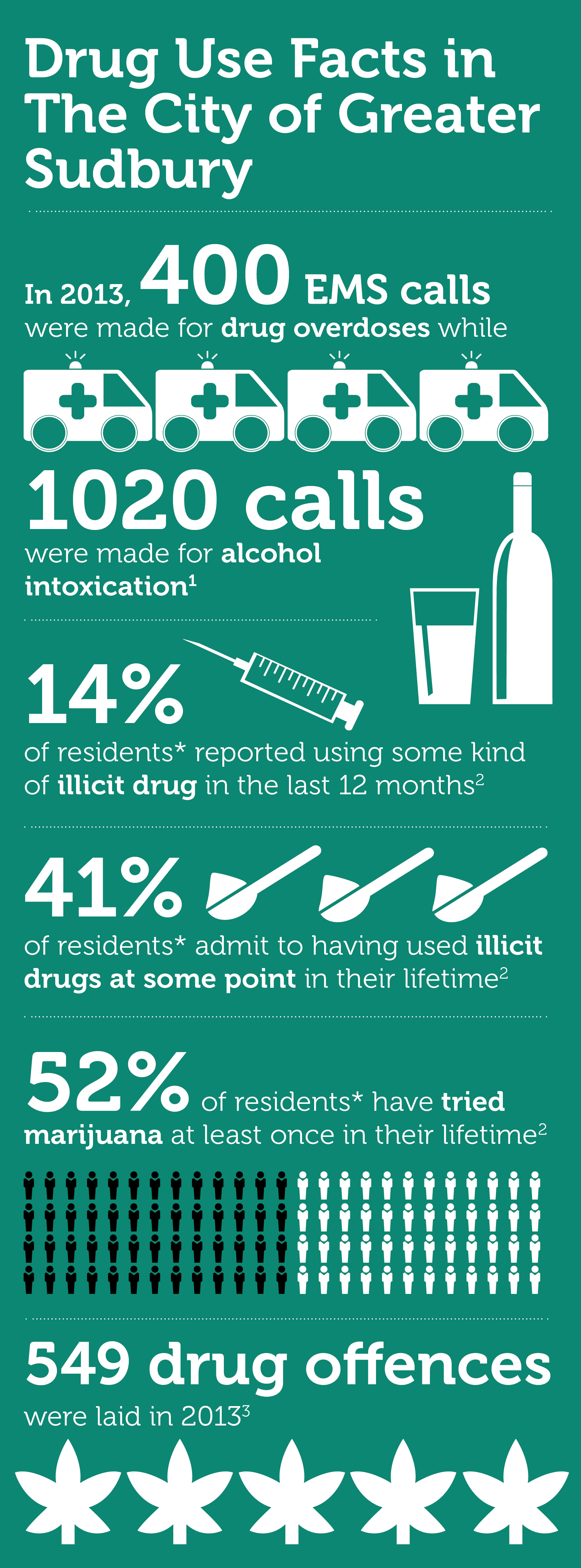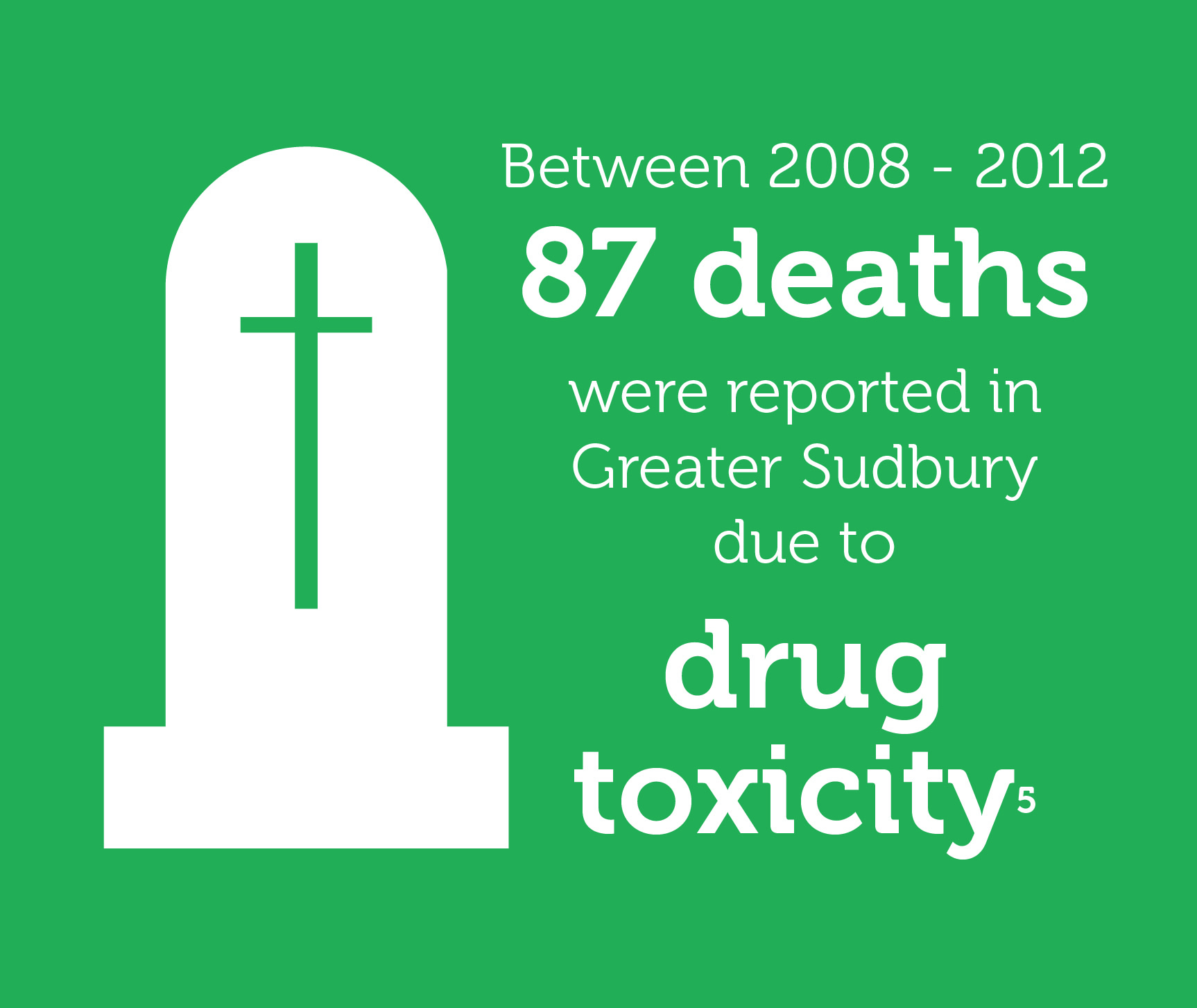A Call to Action
Community Drug Strategy for the City of Greater Sudbury
Substance misuse affects everyone. From the challenges of keeping medications away from children and teens to alcohol misuse in teens and adults; to experimentation with substances and addictions, and accidental poisonings – substance misuse affects all of society.
Experimentation with alcohol, marijuana and other drugs can lead to decisions that put lives at risk. While prescription drugs are intended to restore and maintain health, they can lead to addiction, crime, financial burdens and injury when not used as prescribed. Illegal drugs and related crimes are a source of fear and destruction in our communities. Each year, drinking and driving kills and injures people in our community. The economic impact of substance misuse contributes to preventable social costs. These include costs to the individual’s health and wellbeing and costs to health, enforcement and justice systems.
However we are making a difference.
Pregnant moms are aware of the potential harmful effects of drugs on their unborn babies, therefore they avoid drugs. Parents keep medication out of reach of their children. Educators and parents implement programs to build resiliency in youth to help them make decisions to avoid the dangers of experimenting with drugs. Doctors and pharmacists remind their clients about the risks of misusing prescribed drugs. Friends stop friends from driving impaired.
And we know that we can all do more. We can:
- Learn about drugs that are commonly misused.
- Talk to your family and neighbours about what we have learned.
- Dispose of any old or unused medications.
- Get involved. Our ideas can help find solutions to prevent the initiation of and the harms associated with drug use.
- Let people know we care if we are concerned about their use of substances.
- Seek professional help for ourselves or someone we love.
Together, across all sectors and with an engaged community, we can make a difference.
This Community Drug Strategy report has been created through extensive consultation and provides guidance for our next steps. It is our collective CALL TO ACTION.
Vision
A community working together to improve the health, safety, and well-being of all individuals, families, neighbourhoods, and communities in the city of Greater Sudbury by reducing the incidence of drug use and creating a society increasingly free of the range of harms associated with substance misuse.
Goals
To fulfill this vision we will actively work to:
- Improve community health and address drug-related issues by increasing public awareness of drug use and misuse as a health issue, by providing a range of services including treatment and harm reduction and encouraging a developmental asset building approach to prevention and community development.
- Increase community safety across the city of Greater Sudbury by implementing evidence informed, drug-related crime prevention initiatives.
- Encourage partnerships among municipal government, academia, legal, health and human services sectors, the private sector, and the community to share the responsibility for the development and implementation of substance-related strategies and responses.
- Ensure ongoing monitoring and evaluation of this strategy.
- Encourage all levels of government to take action and responsibility for their elements of the framework within their respective jurisdiction.
Five (5) Foundations
Every building needs a solid foundation. Our drug strategy will be built on five foundations that will be integrated into the plan forming both the support and the structure of our Community Drug Strategy.
1. Health Promotion and Prevention of Drug Misuse
Involves providing coordinated, evidence informed education, awareness-raising activities, developmental asset building approaches to improve youth resiliency and strengthening local policies related to the prevention of drug misuse and its impacts.
2. Treatment
Provides a continuum of necessary interventions and supports to help people regain their health through harm reduction and possible abstinence from drug use.
3. Harm Reduction
Provides strategies to reduce drug-related harm without requiring the cessation of drug use. Interventions may be targeted at the individual, family, community, or society.
4. Enforcement and Justice
Work together to strengthen community safety by responding to crimes and community disorder issues associated with legal and illegal drugs.
5. Sustaining Relationships
Encourage the development of partnerships between the community, sector organizations, and all levels of government.

Drug Use Facts in the City of Greater Sudbury (information from infographic above)
- In 2013, 400 EMS calls were made for drug overdoses while 1020 calls were made for alcohol intoxication¹.
- 14% of residents* reported using some kind of illicit drug in the last 12 months².
- 41% of residents* admit to having used illicit drugs at some point in their lifetime².
- 52% of residents* have tried marijuana at least once in their lifetime².
- 549 drug offences were laid in 2013³.
Ten (10) Guiding Principles
The following principles reflect the key values and beliefs that shape and direct the actions of the Community Drug Strategy for the city of Greater Sudbury:
1. Socially Just
The equality, dignity, rights, and choices of individuals, families, neighbourhoods, and communities are respected.
2. Acceptance
A person’s choice to use or not to use substances is accepted as fact.
3. Diversity
The diversity of people is recognized and incorporated into our responses to substance use issues.
4. Equitable Access
Universal access to appropriate, acceptable services and resources across the city is promoted and ensured.
5. Participation
People are involved in a meaningful way in the development, delivery, and evaluation of research and programs that are intended to serve them.
6. Partnership
All levels of government, academia, legal and human services sectors, the private sector, and the community share the responsibility to develop and implement strategies and responses.
7. Determinants of Health and Health Equity
Strategies address the range of conditions that affect physical, emotional, psychological and spiritual health including safe environment, adequate income, education, appropriate shelter and housing, access to health care, safe and nutritious food, peace, equity, and social justice. Equity in health is promoted.
8. Balance
Initiatives will be balanced to ensure investments are appropriate across the four strategies of prevention, harm reduction, treatment and enforcement.
9. Accountability and Transparency
Clearly defined methods are in place for demonstrating accountability and transparency toward all stakeholders in relation to drug use.
10. Building Assets
Community and individual strengths are used to build capacity of the community.

Student Drug Use Statistics (information from infographic above)
- 16% of students* reported the non-medical use of prescription drugs at least once in the previous 12 months.
- 87% of student users of opioid pain relievers* reported getting the pills at home4.
Nine (9) Key Priorities
- The city of Greater Sudbury implements actions to reduce harms associated with substance use.
- The city of Greater Sudbury is an inclusive city with accessible and appropriate services for its diverse population.
- All people in the city of Greater Sudbury have access to safe, appropriate and affordable shelter and housing.
- All levels of government set public policy and determine spending priorities that support optimal health for all citizens.
- All people in the city of Greater Sudbury have the opportunity for optimal success and health.
- People who use substances have optimal physical, social, emotional, mental and spiritual health.
- People with substance addictions can get well.
- Community members are safe in their neighbourhoods.
- Government, businesses, agencies, neighbourhoods, families and all people work collaboratively and in partnership to build safe and supportive environments.
 Drug Toxicity Statistics (information from infographic above)
Drug Toxicity Statistics (information from infographic above)
- Between 2008 – 2012 87 deaths were reported in Greater Sudbury due to drug toxicity5.
This material has been reproduced or modified with the permission of the Thunder Bay Drug Strategy.
Together, we can make a difference. To learn more contact the Sudbury & District Health Unit by phone at 705.522.9200 or email us at drugstrategy@sdhu.com
1. City of Greater Sudbury, Emergency Medical Services. (2013). Service call data. (J. Amyotte: Personal Communication, 2013).
2. Statistics Canada. (2009-2012). Canadian Community Health Survey (CCHS). Analysed by the Sudbury & District Health Unit (SDHU) July 2014.
3. Greater Sudbury Police Service. (2014). Crime Data-City of Greater Sudbury. (R. Keetch: Personal Communication, 2014).
4. Centre for Mental Health and Addiction. (CMHA). (2013). Drug use among Ontario students, 1977-2013: Detailed OSDUHS findings. Toronto, ON. Retrieved
from: http://www.camh.ca/en/research/news_and_publications/ontario-student-drug-use-and-health-survey/Documents/2013%20OSDUHS%20
Docs/2013OSDUHS_Detailed_DrugUseReport.pdf.
5. Office of the Chief Coroner for Ontario. (2014). Acute Toxicity Statistics for Greater Sudbury (City).
*includes residents in the City of Greater Sudbury and Sudbury and Manitoulin districts.
This item was last modified on May 7, 2024
